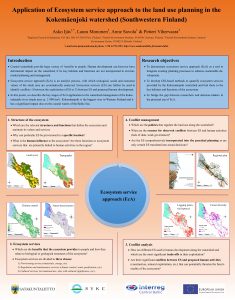Draft of the ICZM case plan to combine the principles of ecosystem service approach and land use planning in the Kokemäenjoki watershed was published in July, 2018 at the webpage of the Regional Council of Satakunta (in Finnish).
In this case, we present a general framework to describe ecological, cultural and economic interests of the case area and to integrate them in a comprehensive way into the planning via the ecosystem service approach (EcA).

Watersheds are complex ecosystems that provide large variety of benefits to the nature and human well-being. The sustainable development of the watersheds cannot be enhanced without an integrated management of both the terrestrial and aquatic environments. The need for integrated management is emphasized in the coastal watersheds where the human pressures may be vulnerable to the marine environments and vice versa.
Kokemäenjoki is the longest river in the southwestern Finland and it discharges to the Bothnian Sea. Kokemäenjoki river valley has been offering favorable conditions for human settlements and practising agriculture as well. Along this case study, we demonstrate the applicability of EcA in the context of the Kokemäenjoki river watershed and how this framework can be utilised to describe different values provided by different ecosystems.
ICZM draft is presented and discussed with local stakeholders during the autumntime 2018. In addition to public presentation, interactive web-based survey https://app.maptionnaire.com/en/4424 is conducted to collect information about the preferences of the locals considering the pleasant places and meaningful activities along the Kokemäenjoki watershed. The final version of the plan is published by the mid-November 2018 after the feedback from the draft has been analysed.
The poster about ‘Integration of ecosystem services to the land use planning’ was originally presented in April, 2018 in the conference of the European Geosciences Union held in Vienna, Austria.
